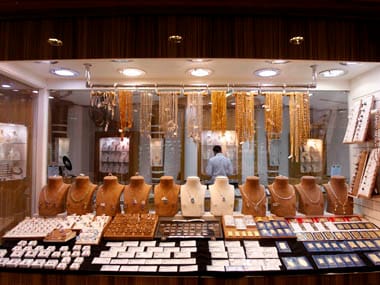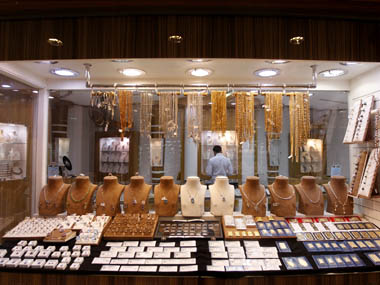Prima facie, there is not much of difference between the existing gold deposit schemes available with certain commercial banks and the proposed gold monetisation scheme (GMS), draft rules for which were released on Tuesday. The GMS is a modified, repackaged version of the existing one. Both follow the same process. An individual or entity walks into a test centre and gets the gold melted, purity assessed and converted into bars, against which the bank will issue a certificate to the holder. On this deposit, the customer earns an interest decided by the bank, which will be exempted from income, wealth or capital gains taxes. On maturity, the customer can get the gold or cash back plus interest amount. [caption id=“attachment_2253632” align=“alignleft” width=“380”]
 Reuters[/caption] The only key difference between the two is the minimum quantity of gold that can be monetised. This has been brought down to 30 grams in the proposed GMS as compared with 500 grams under the existing gold deposit scheme. Hence, this time, the government seems to target HNIs and households rather than temples and trusts, where they hadn’t had much luck anyway. Also, under the new structure banks can use gold to meet their mandatory reserve requirements such as cash reserve ratio (CRR), currently 4 percent, and statutory liquidity ratio (SLR), 21.5 percent. Technically, investment in gold can still be part of SLR holdings, even though in reality most banks resort to buying government bonds to comply with the norm. CRR is the portion of deposits banks need to park with the RBI on a fortnightly basis. If indeed banks manage to mobilise gold from public and use this to meet reserve needs, it can free up funds for lending. The government’s concern on mobilising the domestic, idle stock of gold (about 20,000 tonnes) is understandable given the persisting pressure on the country’s current account deficit on account of huge gold imports. India is the largest importer of gold in the world, buying 800-1000 tonnes of yellow metal from overseas every year. According to the World Bank’s estimates, more than half of the imported gold is used for wedding purposes. But just like its previous form, the scheme is unlikely to be a big success in terms of mobilising gold from individual households since Indians’ penchant for gold has more to do with their culture and tradition. Indians see gold not as a mere investment but more as a symbol of their status. In most Indian households, especially in southern states, gold ornaments are passed on from generations to generations as a family asset, closer to their heart. Parting with gold, by selling or pledging, is perceived as a social ignominy. It is a desperate step taken by an average Indian household in cases of extreme distress. Hence, it would be unwise to expect households to actively participate in any schemes that involve ‘melting’ the long-preserved jewelry. The past performance record of the gold deposit schemes that have so far received lukewarm response is a proof for this. Similarly, mobilising gold stacked in temple reserves too wouldn’t be an easy task since these gold reserves are emotionally linked to religious beliefs and devotees see this as the property of the temple deity. Recently, the Narendra Modi-government had reportedly planned to approach temples across the country to mobilise the idle gold in their vaults, which was met with stiff resistance by religious groups and local politicians. The Kerala government had strongly come out against the reports of the central government’s plan to use temple treasures of Padmanabhaswamy temple in the state capital. “Even if it (the central government) unveils such a scheme, we will not allow to touch the invaluable jewels of Sree Padmanabhaswamy temple or any other places of worship without the consent of the devotees and temples… No one has the right to touch it without the consent of the temple and its devotees,” Kerala chief minister Oommen Chandy
had warned then
. But even with households and temple trusts likely to stay on the sidelines, the GMS may receive some response from private entities and some high networth individuals who want to monetise their gold holdings. But here too, there is a hidden danger of illegal gold holders using this as a safe escape route. As it appears now, the proposed GMS does not have any strong provisions to verify the ownership of gold beyond seeking KYC of the depositor. Hence, the scheme can actually benefit gold smugglers and those who are in possession of unaccounted gold to legitimise their assets. There is no estimate for the unaccounted gold stored in the country. Smuggling of the yellow metal had picked up sharply ever since the government began rising import duties on gold. Unlike other financial instruments, gold doesn’t require an ownership certificate, especially if it is preserved in the form of ornaments. “It is unlikely that the households would be tempted to monetise the gold. This could benefit those who have large holdings of physical gold, mostly in the industry itself and HNIs’ holding gold as part of the portfolio, mutual funds and funds holding gold,” according to Gnanasekar Thiagarajan, director, Commtrendz Research. “It also might benefit unaccounted gold, provided the government doesn’t emphasise on the PAN card requirement to monetise gold,” Gnansekar said. Typically, if a large value transaction takes place in banks, that alerts the tax authorities and other investment agencies, but illegal holders tackle this by splitting the gold into small quantities and depositing/ pledging with multiple banks. Since the existing gold schemes stipulated a 500 grams minimum deposit, illegal holders have abstained from exposing themselves by depositing large quantities of gold. But since the new scheme offers freedom to deposit small quantities, in the present structure, illegal gold holders can actually earn tax free income on assets on which they have never paid any tax.
Reuters[/caption] The only key difference between the two is the minimum quantity of gold that can be monetised. This has been brought down to 30 grams in the proposed GMS as compared with 500 grams under the existing gold deposit scheme. Hence, this time, the government seems to target HNIs and households rather than temples and trusts, where they hadn’t had much luck anyway. Also, under the new structure banks can use gold to meet their mandatory reserve requirements such as cash reserve ratio (CRR), currently 4 percent, and statutory liquidity ratio (SLR), 21.5 percent. Technically, investment in gold can still be part of SLR holdings, even though in reality most banks resort to buying government bonds to comply with the norm. CRR is the portion of deposits banks need to park with the RBI on a fortnightly basis. If indeed banks manage to mobilise gold from public and use this to meet reserve needs, it can free up funds for lending. The government’s concern on mobilising the domestic, idle stock of gold (about 20,000 tonnes) is understandable given the persisting pressure on the country’s current account deficit on account of huge gold imports. India is the largest importer of gold in the world, buying 800-1000 tonnes of yellow metal from overseas every year. According to the World Bank’s estimates, more than half of the imported gold is used for wedding purposes. But just like its previous form, the scheme is unlikely to be a big success in terms of mobilising gold from individual households since Indians’ penchant for gold has more to do with their culture and tradition. Indians see gold not as a mere investment but more as a symbol of their status. In most Indian households, especially in southern states, gold ornaments are passed on from generations to generations as a family asset, closer to their heart. Parting with gold, by selling or pledging, is perceived as a social ignominy. It is a desperate step taken by an average Indian household in cases of extreme distress. Hence, it would be unwise to expect households to actively participate in any schemes that involve ‘melting’ the long-preserved jewelry. The past performance record of the gold deposit schemes that have so far received lukewarm response is a proof for this. Similarly, mobilising gold stacked in temple reserves too wouldn’t be an easy task since these gold reserves are emotionally linked to religious beliefs and devotees see this as the property of the temple deity. Recently, the Narendra Modi-government had reportedly planned to approach temples across the country to mobilise the idle gold in their vaults, which was met with stiff resistance by religious groups and local politicians. The Kerala government had strongly come out against the reports of the central government’s plan to use temple treasures of Padmanabhaswamy temple in the state capital. “Even if it (the central government) unveils such a scheme, we will not allow to touch the invaluable jewels of Sree Padmanabhaswamy temple or any other places of worship without the consent of the devotees and temples… No one has the right to touch it without the consent of the temple and its devotees,” Kerala chief minister Oommen Chandy
had warned then
. But even with households and temple trusts likely to stay on the sidelines, the GMS may receive some response from private entities and some high networth individuals who want to monetise their gold holdings. But here too, there is a hidden danger of illegal gold holders using this as a safe escape route. As it appears now, the proposed GMS does not have any strong provisions to verify the ownership of gold beyond seeking KYC of the depositor. Hence, the scheme can actually benefit gold smugglers and those who are in possession of unaccounted gold to legitimise their assets. There is no estimate for the unaccounted gold stored in the country. Smuggling of the yellow metal had picked up sharply ever since the government began rising import duties on gold. Unlike other financial instruments, gold doesn’t require an ownership certificate, especially if it is preserved in the form of ornaments. “It is unlikely that the households would be tempted to monetise the gold. This could benefit those who have large holdings of physical gold, mostly in the industry itself and HNIs’ holding gold as part of the portfolio, mutual funds and funds holding gold,” according to Gnanasekar Thiagarajan, director, Commtrendz Research. “It also might benefit unaccounted gold, provided the government doesn’t emphasise on the PAN card requirement to monetise gold,” Gnansekar said. Typically, if a large value transaction takes place in banks, that alerts the tax authorities and other investment agencies, but illegal holders tackle this by splitting the gold into small quantities and depositing/ pledging with multiple banks. Since the existing gold schemes stipulated a 500 grams minimum deposit, illegal holders have abstained from exposing themselves by depositing large quantities of gold. But since the new scheme offers freedom to deposit small quantities, in the present structure, illegal gold holders can actually earn tax free income on assets on which they have never paid any tax.
Gold monetisation: Smugglers might be more interested in scheme than households
Dinesh Unnikrishnan
• May 20, 2015, 10:43:57 IST
Since the new scheme offers freedom to deposit small quantities, in the present structure, illegal gold holders can actually earn tax free income
Advertisement
)
End of Article